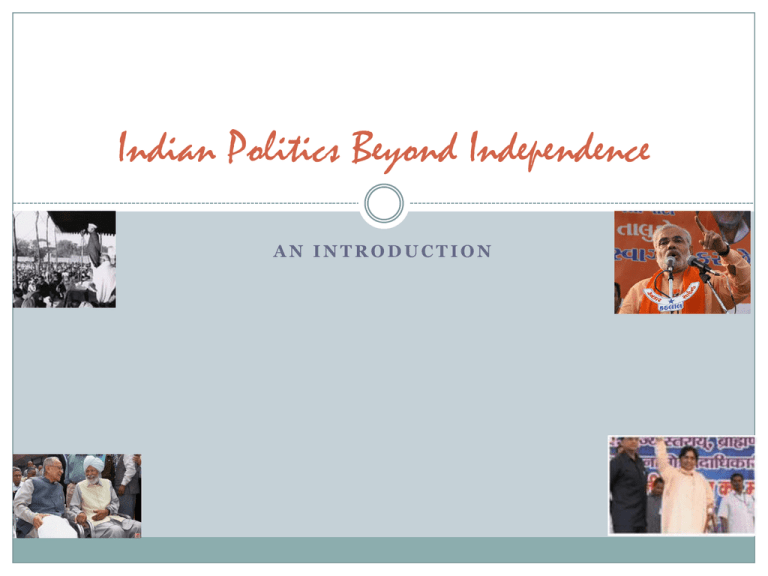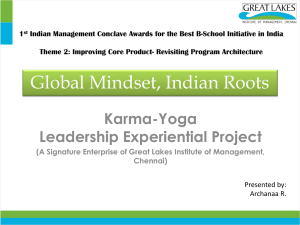
Indian Politics Beyond Independence
AN INTRODUCTION
India: A Social Profile
Population in India today stands at 1,027,015,247. Though India occupies nearly 2% of the earth’s surface it
harbors nearly 15% of world’s population.
About 70% of the people live in more than 550,000 villages, and the remainder in more than 200 towns and
cities.
Almost 40% of Indians are younger than 15 years of age.
The sex ratio (i.e., number of females per thousand males) of population was 933, rising from 927 as at the
1991 Census.
According to the most recent census of 2001, 29 'languages' have more than a million native speakers, 60 have
more than 100,000 and 122 have more than 10,000 native speakers. The government of India has given 22
"languages of the 8th Schedule" the status of official language. The number of languages given this status has
increased through the political process.
Indian census has established that Hinduism accounts for 80% of the population of India. The second largest
religion is Islam, at about thirteen percent of the population. Other native Indian religions are Buddhism,
Jainism, Sikhism. About two percent of Indians adhere to Christianity. Zoroastrianism and Judaism also have
an ancient history in India and each has several thousand Indian adherents.
Caste system: ranking of humans ascribed to them on the basis of birth. Modern Indian caste system could be
classified in three four different ways: a) twice born high caste Hindus; b) agricultural castes classified as
Other Backward Castes who constitute nearly 50% of the population and were provided with a central
government job reservation quota of 27% based on affirmative action policies; c) The Scheduled Castes or
former untouchables who call themselves Dalits or oppressed constitute 15% of the population and were
accorded job reservation quota of 15% and finally there Scheduled Tribes who claim the status of Adivasis or
original inhabitants who rejected the caste system and constitute 7% of the population and were offered a
reservation of 7% of government jobs under affirmative action system.
Q for Discussion: What are the implications of this social profile? How does politics impact social organization
in modern India?
India: Political Profile
India is a parliamentary system of democracy based on universal adult franchise.
India is ruled through federal system of government with clear definition of
jurisdictions of state and central government. It had a far stronger centralizing trait
for federal polity.
Local government below the level of state unit is weak in various parts of rural
India.
It has a very large bureaucracy with a substantially large state controlled economy
and developmental activities.
India has the most diverse range of political parties with the historic Congress party
occupying the center of the political system.
Congress Party is traditionally controlled by the direct descendants of Nehru family.
Recently all political parties, except for Communists and right wing BJP follow the
pattern of dynastic politics.
Q for Discussion : Why was the centralization of power deemed necessary to the
ruling Congress? Was the family rule a consequence of centralization?
Indian Economy : At a Glance
Between 1998-99and 2002-03 Indian economy on average grew at 5.4 per
cent, while the highest growth rate achieved during the period was 6.7 per
cent (in 1998-99). The average growth rate of Indian Economy in the
previous five years (2003-04 to 2007-08) was 8.8 per cent. In the current
year it declined to 6.7%. India by all account is a high performance
economy.
Yet nearly 29% of Indians live below poverty line and approximately 750
million subsist at $2.00 per day.
Though in 2004 service sector contributed to 51.8% of the GDP and
agriculture only 21.2%, a vast majority of Indians depend on agriculture for
their livelihood and they were thus trapped in subsistence oriented
agriculture in rural India.
In urban areas vast majority of Indians depend on informal sector economy
which were outside the tax and salaried segment of the economic
organization.
What does the apparent contradiction in Indian economy imply? How do
we guess about the nature of Indian economy and society from this very
brief outline?
Nature of Indian Society and Politics
Politically, India is a democracy seeking to establish
citizens’ rights through the institutionalization of
human rights and universal adult franchise
Socially, India is struggling to extend principles of
political equality to social sphere and seeking to
promote equality through affirmative action for
socially disadvantaged
Economically, India is seeking to transform a labor
force trapped in subsistence farming agriculture and
informal economy into an industrialized and
organized economy












